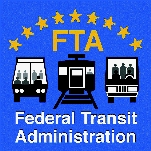Urban Transportation Planning In the United States: An Historical Overview
Like many other segments of the federal government, FTA has made security a priority since 9/11. FTA has conducted risk and vulnerability assessments and deployed technical assistance teams to help strengthen security and emergency preparedness plans at the local and state levels. It also has funded emergency response drills conducted in conjunction with local fire, police and emergency responders. The Safety & Security division provides additional information regarding
;
;
;
;
; and
.
- Norfolk, VA’s The Tide light rail project received $128 million toward building 11 stations, three new park-and-ride structures and a maintenance facility and the purchasing of nine rail vehicles. The Tide, which will cost a total of $232 million to complete and is expected to begin service in 2010, will serve between 6,000 and 12,000 riders per day.
- The Wisconsin Department of Transportation/Bureau of Transit received a grant of $2.2 million to provide operating and planning assistance to areas with a population below 50,000. The grant will be used to expand service in 11 rural areas and to study of the feasibility of bringing public transportation to four additional counties.
- The Center for Transportation and the Environment was awarded a $1.2 million grant for the continued development and demonstration of an improved hybrid fuel cell bus.
|
Regional Transit Authority
|
$67,343,537
|
|
Coach America
|
$36,961,990
|
|
Carter & Burgess, Inc.
|
$32,155,811
|
|
Hill International, Inc.
|
$29,232,671
|
|
Urban Engineers, Inc.
|
$21,438,905
|
|
David Evans and Associates, Inc.
|
$21,250,809
|
|
STV Group, Inc.
|
$20,146,208
|
|
Booz Allen Hamilton, Inc.
|
$18,862,346
|
|
State Of Louisiana
|
$18,746,088
|
|
The Sverdrup Corporation
|
$17,533,471
|
(by Jaikumar Vijayan, ComputerWorld)
- Table of Contents
- Overview
- History
- What it Does
- Where Does the Money Go
- Controversies
- Suggested Reforms
- Comments
- Leave a comment
On July 24, 2014, President Barack Obama nominated Therese W. McMillan as the next administrator of the Federal Transit Administration, where she has served as deputy administrator since 2009.
McMillan is from Inglewood, California, where she attended St. Mary’s Academy. She then went to the University of California at Davis, from where she earned a B.S. in environmental policy and planning analysis in 1981. McMillan worked for two years as a research analyst for Angus McDonald and Associates while attending the University of Californaia at Berkeley. She earned dual degrees; a Master of City Planning and an M.S. in civil engineering science, completing her work in 1984.
McMillan then began a long career at the Metropolitan Transportation Commission (MTC) in the San Francisco Bay area. She started as an associate planner and was named a senior planner in 1988. In 1993, McMillan became manager of finance and was elevated to become manager for finance and external affairs in 1999. After concentration on managing funding, she was named deputy executive director for policy in 2001, a role she held until moving to Washington. She managed the commission’s strategic financial planning and its funding for Bay Area transportation projects.
McMillan’s husband, Rod McMillan, also worked for the MTC. They have two daughters, Nadine and Madeline.
-Steve Straehley
To Learn More:

An expert in federal infrastructure budgeting and finance, Peter M. Rogoff was confirmed on May 21, 2009, as the Administrator of the Federal Transit Administration. Rogoff spent the past two decades working for the U.S. Senate as a key aide to Democratic lawmakers. His experience on Capitol Hill, which included work on a transportation subcommittee, will come in handy running the Federal Transit Administration (FTA), which distributes more than $10 billion a year to support state and local transportation programs across the country.
- Latest News
- D.C. Public Schools will Teach all Second-Graders to Ride a Bike
- New Rule in Germany Limits Sales of Sex-Themed E-Books to 10pm to 6am
- What Happened to the 6-Year-Old Tibetan Boy the Chinese Government Kidnapped 20 Years Ago?
- U.S. Ambassador to Turkey Photoshops his Hair Color to Mock Turkish Mayor
- Mystery Artist Calls Attention to Unfixed Potholes by Drawing Penises around Them
Urban Transportation Planning In the United States: An Historical Overview
Like many other segments of the federal government, FTA has made security a priority since 9/11. FTA has conducted risk and vulnerability assessments and deployed technical assistance teams to help strengthen security and emergency preparedness plans at the local and state levels. It also has funded emergency response drills conducted in conjunction with local fire, police and emergency responders. The Safety & Security division provides additional information regarding
;
;
;
;
; and
.
- Norfolk, VA’s The Tide light rail project received $128 million toward building 11 stations, three new park-and-ride structures and a maintenance facility and the purchasing of nine rail vehicles. The Tide, which will cost a total of $232 million to complete and is expected to begin service in 2010, will serve between 6,000 and 12,000 riders per day.
- The Wisconsin Department of Transportation/Bureau of Transit received a grant of $2.2 million to provide operating and planning assistance to areas with a population below 50,000. The grant will be used to expand service in 11 rural areas and to study of the feasibility of bringing public transportation to four additional counties.
- The Center for Transportation and the Environment was awarded a $1.2 million grant for the continued development and demonstration of an improved hybrid fuel cell bus.
|
Regional Transit Authority
|
$67,343,537
|
|
Coach America
|
$36,961,990
|
|
Carter & Burgess, Inc.
|
$32,155,811
|
|
Hill International, Inc.
|
$29,232,671
|
|
Urban Engineers, Inc.
|
$21,438,905
|
|
David Evans and Associates, Inc.
|
$21,250,809
|
|
STV Group, Inc.
|
$20,146,208
|
|
Booz Allen Hamilton, Inc.
|
$18,862,346
|
|
State Of Louisiana
|
$18,746,088
|
|
The Sverdrup Corporation
|
$17,533,471
|
(by Jaikumar Vijayan, ComputerWorld)
Comments
On July 24, 2014, President Barack Obama nominated Therese W. McMillan as the next administrator of the Federal Transit Administration, where she has served as deputy administrator since 2009.
McMillan is from Inglewood, California, where she attended St. Mary’s Academy. She then went to the University of California at Davis, from where she earned a B.S. in environmental policy and planning analysis in 1981. McMillan worked for two years as a research analyst for Angus McDonald and Associates while attending the University of Californaia at Berkeley. She earned dual degrees; a Master of City Planning and an M.S. in civil engineering science, completing her work in 1984.
McMillan then began a long career at the Metropolitan Transportation Commission (MTC) in the San Francisco Bay area. She started as an associate planner and was named a senior planner in 1988. In 1993, McMillan became manager of finance and was elevated to become manager for finance and external affairs in 1999. After concentration on managing funding, she was named deputy executive director for policy in 2001, a role she held until moving to Washington. She managed the commission’s strategic financial planning and its funding for Bay Area transportation projects.
McMillan’s husband, Rod McMillan, also worked for the MTC. They have two daughters, Nadine and Madeline.
-Steve Straehley
To Learn More:

An expert in federal infrastructure budgeting and finance, Peter M. Rogoff was confirmed on May 21, 2009, as the Administrator of the Federal Transit Administration. Rogoff spent the past two decades working for the U.S. Senate as a key aide to Democratic lawmakers. His experience on Capitol Hill, which included work on a transportation subcommittee, will come in handy running the Federal Transit Administration (FTA), which distributes more than $10 billion a year to support state and local transportation programs across the country.
- Latest News
- D.C. Public Schools will Teach all Second-Graders to Ride a Bike
- New Rule in Germany Limits Sales of Sex-Themed E-Books to 10pm to 6am
- What Happened to the 6-Year-Old Tibetan Boy the Chinese Government Kidnapped 20 Years Ago?
- U.S. Ambassador to Turkey Photoshops his Hair Color to Mock Turkish Mayor
- Mystery Artist Calls Attention to Unfixed Potholes by Drawing Penises around Them






Comments